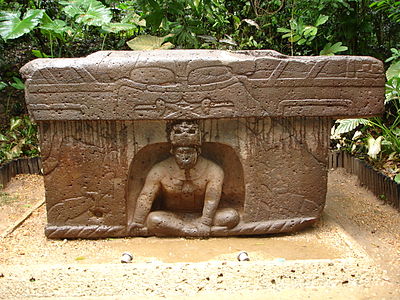"Reviews the large scale excavations of the Olmec site of La Venta begun in 1955. Includes a study of the results of the earlier investigations in 1942 and 1943, with representative examples of primitive sculptures, carvings, and constructions found at the excavation site."
Terms / Concepts
- theocratic government
- priesthood
- "Olmec art style"
- Quetzalcoatl ("The Plumed Serpent")
Notes
- Pay close attention to the figurines
- here the dry season begins in late February and ends in May
- practice slash-and-burn agriculture
- "cruciform pattern" probably the "tree of life"
- Olmec mirrors = earliest mirrors worldwide
- "Mesoamerican Style" includes pyramids, stone sculpture, carved
jade
- jade and green serpentine (green color) favorites to the Olmecs
- "island could sustain only 150 persons"
- site extended one-half mile along the island
- La Venta was built in four major stages, with a new phase "occurring
about every 100 years"
[52 X 2; every 104 years aligns with Venus
cycle]
- The Jaguar is a "favorite Olmec deity"
- the serpentine was brought 150 miles from the Gulf Coast
- [James A. Michener indicated that of about 75 civilizations that
existed, only a handful lasted as long as 1000 years]
Cultures
Sites / Locations
- La
Venta (ca. 800 - 400 B.C.)
- Tonala River (Gulf of Compeche)
- pyramids, stone sculpture, carved jade
- 2 square miles of dry land
- the island can not sustain more than 150 persons
- the site of La Venta extended for 1/2 mile along the Island's
low central ridge
- aligned 8 degrees west of true north
- deformed skullls / head flattening
- slash and burn agriculture (swidden agriculture)
- note the symmetry of the center
- the center line must have had special religious or magical
significance
- was rebuilt about every 100 years (104 years = 52 X 2)
- jade and serpentine are important
- in size, it is one of the smallest of the capitals of civilization,
although it is complex, and had an influence in Mesoamerica until
the arrival of the Spanish
- fisheries were first and were then overlaid with maize agriculture
- bulldozed
- Features
- "ambassador monument"
- "rattlesnake monument"
- "The Whale"
- glyphic writing (hieroglyphics)
- figurine group
- pyramids
- monolithic flat-topped altars
- mosaic pavements (65 square feet)
- sculptured monuments
- jaguar mask
- carved jade and serpentine
- Tres Zapotes
- San Lorenzo
- Veracruz
- Tobasco
Individuals
Publications
- Review: Coe, Michael D. 1967. American Anthropologist
69: 127-128.
- Drucker, P., Heizer, R.F. and Squier, R.J. 1959. "Excavations
at La Venta, Tobasco, 1955, Bureau of American Ethnology, Bulletin 170. Washington: Smithsonian Institution.

"Altar 4 at La Venta. Note the rope that winds along the ground, held by the figure. Note also the eyes and the fangs on the cornice above the figure, implying that the figure is seated in that creature's mouth."
La Venta -- Wikipedia
|
